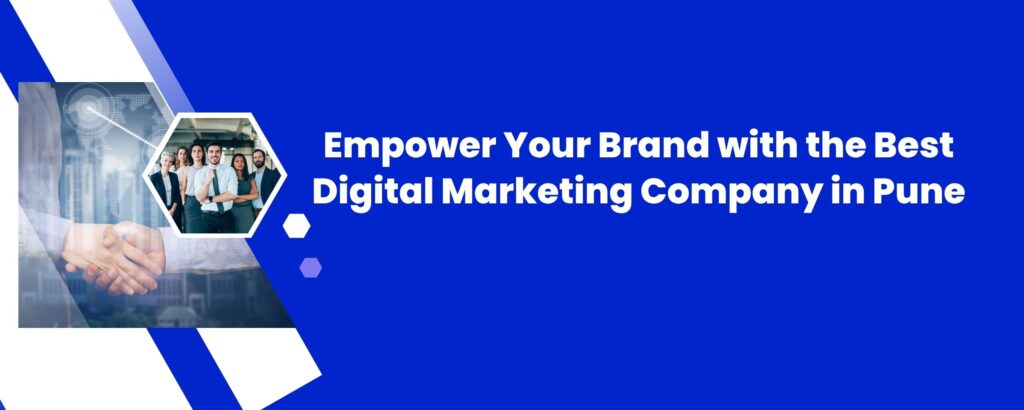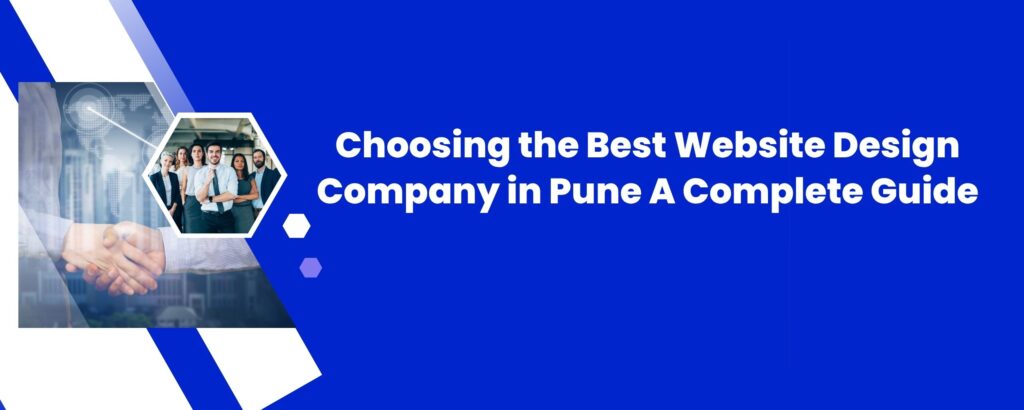Empower Your Brand with the Best Digital Marketing Company in Pune

In today’s digital-first era, traditional marketing alone is no longer enough. Businesses now operate in a highly competitive online environment where visibility, engagement, and user experience determine success. To stand out, you need a partner that understands the ever-changing digital landscape—a partner like the best digital marketing company in Pune. With millions of consumers searching, shopping, and interacting online, digital marketing is not just a strategy—it’s the lifeblood of modern business growth. Pune, being one of India’s fastest-growing tech hubs, offers access to innovative and performance-driven digital marketing solutions for brands looking to scale. Why Working with the Best Digital Marketing Agency in Pune Is Crucial for Success Digital marketing encompasses all the techniques used to promote a brand or product through online channels. From search engines and social media to email campaigns and paid ads, it connects businesses to their target audience with precision and personalization. Key Benefits of Choosing a Top Digital Marketing Company Measurable ROI: Track campaigns in real time to optimize results and budget. Wider Reach: Connect with both local and global customers across platforms. Cost-Effective: Achieve greater impact at lower cost compared to traditional marketing. Brand Authority: Build trust, loyalty, and reputation through consistent online visibility. When executed correctly, digital marketing becomes a growth engine for lead generation, sales, and long-term brand success. Pune: Why It’s the Ideal City to Find the Best Digital Marketing Company Pune has emerged as a leading center for technology, education, and innovation. The city hosts a vast pool of skilled digital marketers, tech experts, and creative professionals. Advantages of Choosing a Pune-Based Digital Marketing Partner Working with the best digital marketing company in Pune ensures: Access to global-standard talent at competitive prices Local market expertise and cultural understanding Agile and collaborative project management Cutting-edge strategy aligned with global trends Core Services Offered by the Top Digital Marketing Companies in Pune Digital marketing agencies in Pune provide a wide range of customized services tailored to your brand and target market. Search Engine Optimization (SEO) from Pune’s Leading Digital Marketing Experts Improve your visibility in search engine results with keyword research, technical optimization, and content strategies that drive organic traffic. ROI-Driven PPC Campaigns by the Best Digital Marketing Agency in Pune Leverage Google Ads and other platforms to generate immediate, high-converting traffic through strategic ad placements. Social Media Marketing Solutions from Top Digital Marketing Firms in Pune Create engaging content and run precise ad campaigns across Facebook, Instagram, LinkedIn, and Twitter to build brand loyalty and engagement. Content Marketing by the Best Digital Marketing Professionals in Pune Build trust and authority with blogs, articles, videos, and infographics that educate, engage, and convert. Email Campaigns Crafted by Top-Rated Digital Marketing Teams in Pune Drive customer retention and repeat sales through personalized and automated email flows. Website Design & Development Backed by Digital Strategy Build responsive, fast-loading, and SEO-optimized websites that offer seamless user experiences and support business goals. Online Reputation Management (ORM) by Experts in Pune Protect and improve your brand’s online image with review monitoring, crisis response, and customer feedback engagement. Advanced Analytics & Marketing Insights from Leading Digital Agencies Make smarter marketing decisions using real-time data and reporting dashboards customized to your KPIs. What Makes the Best Digital Marketing Company in Pune Truly Stand Out? When comparing options, the best agencies share a few key traits: Results-Oriented: Focused on KPIs that matter—like leads, conversions, and ROI. Custom Strategies: Tailored campaigns that align with your industry and business goals. Experienced Teams: Certified professionals in SEO, paid ads, design, content, and analytics. Transparency: Clear reporting, constant communication, and full accountability. Ethical Approach: White-hat strategies that ensure long-term online success. The right digital marketing partner becomes an extension of your team, helping you grow and compete online with confidence. Industries Benefiting from Services Offered by Top Digital Marketing Companies in Pune Digital marketing is flexible and scalable, making it ideal for businesses of all types and sizes. IT & SaaS: Generate B2B leads using SEO and LinkedIn outreach. Education: Attract more enrollments with PPC, content, and video campaigns. Healthcare: Reach local patients via Google Maps, SEO, and reviews. E-commerce: Increase sales through retargeting ads and influencer collaborations. Real Estate: Drive qualified leads through localized ad campaigns and 3D walkthroughs. Hospitality: Boost bookings using email promotions, local SEO, and social media content. No matter your industry, the best digital marketing company in Pune can customize strategies that deliver growth. Why You Should Hire a Local Digital Marketing Agency in Pune Hiring a local partner offers unique benefits: Faster Communication: Enjoy quicker response times and face-to-face collaboration. Market Insight: Tap into deep knowledge of local trends and consumer behavior. Affordable Expertise: Access high-quality service at lower cost than in Mumbai, Delhi, or Bangalore. Scalability: Local firms offer flexible packages that grow with your business. Choosing a Pune-based agency offers both performance and partnership. The Future of Digital Marketing with Pune’s Best Agencies As technology evolves, staying updated is key to continued growth. Here’s how the best digital marketing agency in Pune helps you stay ahead: AI and Automation: Smarter tools for ad targeting, content optimization, and audience analysis. Voice Search Optimization: Adapting content for voice-command search queries. Video Content Growth: Creating engaging YouTube Shorts, Reels, and live content. Hyperlocal Targeting: Location-specific campaigns using geofencing and micro-targeting. Interactive Experiences: Polls, 360° tours, quizzes, and gamification to boost engagement. The best agencies combine these trends with strategy and execution that deliver lasting results. Final Thoughts: Partner with the Best Digital Marketing Company in Pune In a digital world where attention spans are short and competition is fierce, having the right digital marketing partner makes all the difference. The best digital marketing company in Pune helps you build trust, generate leads, and scale efficiently. Whether you want to grow your presence locally or compete globally, partnering with an expert team is the smartest move you can make. Ready to Elevate Your Brand Online? Team up with Nucleosys Tech, Pune’s most trusted digital marketing experts. Discover data-driven growth
Boost Your Online Visibility with Top SEO Services in Pune

In the fast-evolving digital landscape, businesses need more than a website—they need visibility, credibility, and traffic. One of the most effective ways to achieve these goals is through professional SEO services in Pune. Whether you’re a start-up, SME, or a large corporation, SEO can elevate your brand, drive qualified leads, and deliver long-term digital success. With countless companies competing for attention online, showing up on the first page of search engines is critical. That’s where expert SEO steps in—offering a strategic, data-driven approach to improving your website’s performance and making your brand stand out in the crowded online marketplace. Why SEO Is a Must-Have for Every Business Search engine optimization is the foundation of digital growth. As users increasingly rely on Google and other search engines to find products, services, and solutions, SEO ensures your business is visible when and where it matters most. Unlike paid advertising, which stops when your budget ends, SEO provides continuous, organic growth. It enhances your brand’s discoverability, improves user experience, and increases conversion rates—all while offering one of the highest returns on investment in digital marketing. Pune: A Growing Hub for Digital Innovation Pune is quickly emerging as a powerhouse in technology and innovation. Its thriving start-up ecosystem, pool of skilled professionals, and cost-effective service environment make it a top destination for businesses seeking cutting-edge digital solutions. Many leading brands trust agencies offering SEO services in Pune to enhance their online presence. These agencies combine local market understanding with global SEO trends to craft strategies that work across industries and audiences. From keyword research to link-building, Pune’s SEO experts bring a holistic, ROI-focused approach to digital marketing that helps businesses gain a competitive edge. What Do SEO Services in Pune Include? SEO isn’t just about keywords or backlinks—it’s about building a long-term digital strategy that drives measurable results. Here are the core components you can expect from a leading SEO agency in Pune: 1. Comprehensive Website Audit Before creating a strategy, experts begin with a thorough audit of your website to identify technical issues, content gaps, and areas of improvement. This helps set a clear foundation for optimization. 2. In-Depth Keyword Research Using advanced tools, agencies uncover high-value keywords your target audience is searching for. These keywords are strategically used to align content with user intent and boost your visibility on search engines. 3. On-Page SEO On-page optimization focuses on improving elements like title tags, headers, image alt texts, internal links, and URL structures. All these updates help search engines better understand your site while improving the user experience. 4. Technical SEO This involves enhancing your site’s backend to improve speed, mobile responsiveness, crawlability, and indexability. A technically sound website ranks better and performs more reliably. 5. Quality Content Creation Content is a powerful SEO tool. Agencies create engaging blog posts, service pages, and landing pages that not only include target keywords but also provide real value to readers. 6. Link Building and Outreach Acquiring backlinks from reputable websites increases your site’s authority. Ethical and high-quality link-building strategies are a major part of long-term SEO success. 7. Local SEO Optimization For businesses targeting customers in Pune or nearby regions, local SEO is essential. This includes optimizing your Google Business Profile, collecting reviews, and appearing in local search results. Why Choose Local SEO Experts in Pune? There’s a significant advantage to hiring a local SEO partner. Agencies based in Pune understand the regional market, customer behavior, and competitive landscape, allowing them to craft more targeted and effective strategies. Here are a few reasons businesses prefer working with local SEO specialists: Cultural Relevance: Local agencies grasp the nuances of language, tone, and user behavior better than remote teams. Budget-Friendly: Compared to major metros, Pune offers top-tier services at competitive rates, maximizing your return on investment. Easy Communication: Being in the same time zone and geographic area facilitates quicker support and collaboration. From understanding your market to delivering data-driven strategies, Pune-based SEO experts offer personalized services that align with your goals and audience. Industries Benefiting from SEO in Pune The flexibility of SEO makes it suitable for almost every business sector. Here’s how different industries in Pune are leveraging SEO: IT & SaaS Companies: To attract global B2B clients and drive lead generation. Real Estate: Builders and agents use SEO to rank for location-based property searches. Healthcare: Clinics and hospitals optimize to reach local patients searching for specific treatments or specialists. E-Commerce: Online stores enhance product visibility, resulting in higher sales and brand awareness. Education: Institutes use SEO to reach students across India and globally. Whatever your industry, SEO can be customized to help you connect with your ideal audience at the right moment. How to Evaluate the Right SEO Partner Not all SEO providers offer the same quality of service. To choose the right partner in Pune, consider these key factors: Proven Track Record: Look for case studies, testimonials, and client success stories. Customized Solutions: Avoid one-size-fits-all approaches. Your business needs a strategy tailored to your niche. Transparency: Choose a partner that offers regular reporting, clear timelines, and measurable goals. Up-to-Date Knowledge: SEO is dynamic. Make sure your agency keeps up with Google’s updates and industry best practices. Ethical Practices: White-hat SEO ensures long-term rankings without penalties. A trustworthy SEO partner will treat your brand as their own and focus on sustainable growth, not just quick wins. Measuring SEO Success SEO success isn’t just about ranking for keywords. Reputable agencies track multiple KPIs to ensure progress is tangible and aligned with your business objectives: Organic traffic growth Keyword ranking improvements Bounce rate reduction Increased average session duration Higher conversion rates Growth in leads and sales These insights help refine strategies over time and provide clear evidence of return on investment. The Future of SEO in Pune As businesses continue to embrace digital transformation, SEO will play an even more crucial role. Here’s what the future looks like: Voice Search Optimization: With smart assistants on the rise, SEO strategies are adapting to natural language queries. AI
Top 5 SEO Company in Pune: Unlocking Digital Growth with Proven Results

In today’s digital era, your business visibility on search engines can make or break your success. Whether you’re a startup, a small business, or a large enterprise, optimizing your online presence has become non-negotiable. Pune, being one of India’s fastest-growing IT hubs, is home to many SEO agencies that promise digital growth. But choosing the right one is key to achieving measurable results. This blog explores the Top 5 SEO Company in Pune that stand out due to their expertise, customer satisfaction, and consistent performance. Why Hiring the Best SEO Services in Pune Matters Search Engine Optimization (SEO) is more than just ranking on Google. It’s about driving the right audience to your website, increasing conversions, and building long-term digital equity. The right agency doesn’t just deliver traffic—they deliver results aligned with your business goals. From keyword research and on-page SEO to link building and performance tracking, a dedicated SEO company offers a comprehensive solution. Partnering with one of the Pune-based SEO experts can provide local market insight, industry-relevant strategies, and faster turnarounds. Top-rated SEO Agencies in Pune That Deliver Results Let’s dive into the most reliable and result-driven agencies you can count on. 1. Nucleosys Tech – Leading SEO Company in Pune Website: https://nucleosystech.com/ At the top of our list is Nucleosys Tech, a reputed name in the digital marketing landscape of Pune. They offer tailored SEO solutions that cover everything from technical SEO audits to local SEO strategies. With a robust team of professionals and a client-centric approach, Nucleosys Tech has helped several brands climb the search engine ladder efficiently. They are known for offering the Best SEO services in Pune with transparency, ethical practices, and data-driven methodologies. Their strong portfolio includes successful campaigns for businesses across various industries—IT, education, hospitality, and e-commerce. 2. Brainmine Web Solutions – Trusted Digital Marketing Agency Brainmine has built its reputation as one of the top-rated SEO agencies in Pune by delivering ROI-focused strategies. The company blends creativity with analytics to drive performance, making it a trusted name for businesses that want to improve their digital footprint. Their strength lies in keyword optimization, content strategy, and competitor analysis. Brainmine ensures that every campaign aligns with the client’s marketing goals. They also provide PPC, web design, and social media marketing, offering a complete digital package. 3. Dimakh Consultants – Professional SEO Firm in Pune With over two decades in the digital industry, Dimakh Consultants is a Pune-based agency specializing in performance marketing and technical SEO. Their commitment to quality has earned them a strong reputation among professional SEO firms in Pune. Their SEO packages are flexible, which makes them suitable for startups, SMEs, and large enterprises alike. The team emphasizes detailed reporting and continuous optimization, ensuring that your website adapts to changing algorithms. 4. IKF – Affordable Digital Marketing Company in Pune IKF is one of the most experienced digital marketing companies in Pune with a focus on strategic SEO. Their data-backed SEO strategies are designed to boost online visibility and conversion rates. They are particularly strong in local SEO, helping businesses rank higher in geographically targeted searches. If you’re looking for affordable digital marketing companies in Pune without compromising on quality, IKF is a strong contender. Their results are backed by strong analytics and client testimonials. 5. Public Media Solution – Agile SEO Services Provider Public Media Solution combines content-driven SEO with advanced analytics to deliver impressive results. Their focus on both on-page and off-page SEO tactics allows businesses to rank sustainably over time. They also provide PR, branding, and ORM services, making them a full-service agency. What makes them unique is their agile approach—perfect for brands needing fast execution and dynamic strategies. If you’re seeking performance and scalability, this firm deserves your attention. What to Expect from the Top 5 SEO Company in Pune Here are some common features that the Top 5 SEO Company in Pune share: Comprehensive SEO Audits: A deep dive into your website’s health and visibility. Keyword Strategy: Not just high-volume keywords but intent-based targeting. On-page Optimization: Structuring your site for better user experience and crawlability. Content Marketing: Creating engaging, keyword-rich content to drive organic growth. Technical SEO: From sitemap optimization to fixing crawl errors, all bases are covered. Backlink Building: Earning high-quality links from trusted sources. Transparent Reporting: Regular updates with actionable insights. How to Choose Pune-Based SEO Experts for Your Business Every business has unique needs. Here are factors to consider while selecting from the Top 5 SEO Company in Pune: Industry Experience: Choose a company that understands your niche. Customization: Avoid one-size-fits-all strategies. Your SEO plan should be tailored. Case Studies & Testimonials: Look for proven track records. Pricing Transparency: Select an agency that’s clear and honest about costs. Communication: Regular updates and accountability are key to long-term success. Why Pune Is a Hotspot for Professional SEO Firms Pune’s growth as an IT and startup center has fueled demand for high-quality SEO services. The city is teeming with talent, innovation, and competitive pricing—making it an ideal destination for digital marketing outsourcing. Companies based here often bring a mix of traditional SEO know-how and modern marketing techniques. As a result, many businesses outside Pune are also partnering with these agencies to gain a competitive edge. Final Thoughts on Hiring the Top 5 SEO Company in Pune Investing in the right SEO agency is one of the most critical decisions for any business today. Whether you’re aiming for higher visibility, more traffic, or better conversion rates, the companies listed above are among the best options to consider. From technical audits to content marketing and local SEO, they offer a full spectrum of services tailored to your needs. The Top 5 SEO Company in Pune mentioned in this blog are known for their commitment to delivering tangible results. By leveraging the power of SEO, they help brands not just to be seen—but to be chosen. If you’re serious about unlocking your digital potential, now is the time to connect with one of these Pune-based SEO experts
Boost Your Online Visibility: Choose the Best Seo Company in Pune

In today’s hyper-competitive online marketplace, having a powerful digital presence is no longer optional—it’s a necessity. Whether you’re a startup, mid-sized firm, or an established brand, visibility on search engines plays a vital role in business success. To achieve this, partnering with a professional Seo Company in Pune can be a game-changer. Why SEO Is Still Relevant in 2025 Despite rapid changes in digital trends, SEO remains one of the most cost-effective and high-ROI marketing strategies. Unlike paid ads, which offer temporary visibility, search engine optimization creates long-term traction. An effective SEO campaign ensures your business ranks well on Google, drives organic traffic, and converts visitors into loyal customers. However, modern SEO is more complex than ever. It involves technical improvements, content quality, keyword strategy, mobile responsiveness, and authority building. That’s why businesses in Maharashtra’s digital hub are turning to experienced seo agency in Pune solutions for tailored and sustainable growth strategies. Why Pune Is the Ideal City for SEO Services Pune is rapidly emerging as a digital and IT powerhouse. With a rich talent pool, tech-friendly environment, and growing number of startups, it offers the perfect ecosystem for digital marketing innovation. This has led to the rise of many reputable agencies providing affordable SEO services in Pune, each catering to various business needs—from local optimization to global market outreach. Moreover, Pune-based SEO agencies are highly adaptable. They combine local market understanding with global SEO best practices, ensuring your brand stays ahead in the competition both locally and internationally. What to Expect from a Professional Seo Company in Pune When you collaborate with an experienced SEO firm, you’re investing in a multi-faceted strategy. Here’s what most leading SEO service providers in Pune bring to the table: 1. SEO Audit and Performance Review Before crafting a new strategy, a full-scale SEO audit is conducted. This helps analyze your site’s current status, uncover technical issues, and evaluate content gaps. Competitor analysis is also conducted to identify what works in your industry. 2. On-Page Optimization A vital part of SEO, this includes optimizing your website structure, meta tags, URLs, internal linking, image alt texts, and content hierarchy to ensure it is search-engine friendly. 3. Technical SEO Enhancements A technically sound website improves both crawlability and user experience. SEO companies ensure your site loads fast, works well on mobile devices, uses HTTPS, and implements proper schema markup. 4. Content Strategy Content that is relevant, informative, and optimized for the right keywords boosts engagement and search visibility. Many agencies in Pune offer end-to-end content planning, creation, and optimization services. 5. Backlink Building Creating high-quality backlinks from trusted domains is essential for authority building. A reliable seo agency pune focuses on ethical and white-hat link-building practices that follow Google’s guidelines. 6. Local SEO If your business relies on a local customer base, local SEO becomes crucial. This includes optimizing your Google Business Profile, collecting customer reviews, local directory submissions, and location-specific content. Why You Need the Best Seo Agency in Pune Not all SEO providers are created equal. Here’s why choosing the best seo agency in Pune can significantly impact your business outcomes: Customized Solutions: Your business is unique, and your SEO strategy should reflect that. Top agencies offer personalized plans instead of one-size-fits-all packages. Data-Driven Decisions: Using tools like Google Analytics, Search Console, and advanced reporting dashboards, the best agencies make informed decisions to improve campaign performance. Transparent Reporting: Professional firms offer clear reporting on ranking improvements, traffic growth, and ROI metrics. Proactive Communication: You’ll always be in the loop with regular updates, strategy reviews, and performance metrics. The best seo company in Pune doesn’t just focus on rankings—it focuses on your complete digital growth. Their success is tied to yours. Benefits of Choosing an SEO Partner in Pune When you collaborate with a specialized SEO partner in Pune, you gain more than just keyword rankings. Here’s how your business can benefit: Increased Organic Traffic: With targeted strategies, your website becomes more visible for relevant search queries. Higher Conversion Rates: Well-optimized pages are not only search-friendly but also user-centric, leading to better engagement and more sales. Improved Brand Visibility: Top positions in search results build credibility and brand recognition. Sustainable Growth: Unlike short-term ads, SEO builds momentum that drives continuous traffic and revenue. Cost-Effective Marketing: Especially for small to mid-sized businesses, SEO offers excellent returns compared to other digital marketing methods. Choosing the Right Partner: Key Considerations Selecting the right SEO partner is crucial to your online success. Here’s what to evaluate when picking an SEO company or agency: Proven Track Record: Look for case studies, client reviews, and before/after performance data. Industry Experience: Choose an agency with experience in your specific sector. Ethical Practices: Avoid companies offering shortcuts or black-hat techniques. Scalable Solutions: Your SEO needs will evolve; ensure your agency can grow with you. Working with a Seo Company in Pune that checks all these boxes ensures your brand thrives in the digital space, regardless of industry. Real-Time Impact: Case Study Snapshot Take, for example, a mid-sized e-commerce brand in Pune that partnered with a local SEO agency. Within six months of implementing a new strategy, they saw: 125% increase in organic traffic 3x rise in daily leads Improved site performance and user experience First-page ranking for 15+ competitive keywords This transformation wasn’t just about rankings—it was about aligning SEO with real business goals. Conclusion: Invest in Your Brand’s Future SEO is more than a trend—it’s a long-term digital investment. If you want sustainable growth, improved visibility, and better returns, now is the time to work with a trusted Seo Company in Pune. With the right strategy and support, your business can dominate the digital landscape and connect with the right audience at the right time. Whether you’re looking for comprehensive SEO audits, content strategies, or local optimization, Pune has a thriving ecosystem of professionals ready to help. Don’t settle for average results—partner with the best seo agency in Pune and unlock your true digital potential.
Struggling with Brand Visibility? Here’s Why You Need a Branding Agency in Pune

In a competitive world where attention spans are short and choices are endless, businesses must do more than simply exist. They need to stand out, connect, and influence. The secret behind many successful businesses isn’t just a great product or service—it’s a powerful brand. If you’re looking to build a brand that turns heads and wins loyalty, partnering with a branding agency in Pune could be your smartest move. What Is Branding and Why Does It Matter? Branding is the art and science of defining how your business is perceived. It’s not limited to a logo or a catchy tagline. Branding encompasses your values, tone of voice, visual identity, and the experience you offer your customers. It’s the promise you make and the story you tell. A strong brand: Builds trust and credibility Enhances customer recall Creates emotional connections Supports premium pricing Drives long-term loyalty Without branding, your business is just another name in the crowd. Pune: The Emerging Hub for Creative Branding Pune has quickly emerged as one of India’s most dynamic cities for digital innovation, design, and business growth. With a rising number of startups, tech companies, and creative professionals, the city offers a rich ecosystem for businesses looking to build impactful brands. A professional branding agency in Pune offers the ideal mix of creativity, strategy, and affordability. From understanding local nuances to delivering globally relevant work, these agencies are equipped to elevate your business to the next level. What Services Can a Branding Agency Offer? When you engage a branding agency, you’re investing in more than just design. You’re hiring a team of thinkers, strategists, and creatives who craft a brand that resonates with your audience. Typical services include: Brand Strategy & PositioningDefining your market niche, brand values, and customer persona. Logo & Visual IdentityDesigning unique logos, color schemes, typography, and visual styles. Brand MessagingCreating a consistent voice, mission statement, and brand story. Website & Digital AssetsDeveloping branded websites, social media creatives, email templates, and more. Packaging & Print CollateralDesigning product packaging, business cards, brochures, and banners. Brand GuidelinesA complete brand manual for consistency across all communication platforms. With a top-tier branding agency in Pune, you get a 360-degree solution for building a brand that works both visually and strategically. When Should You Hire a Branding Agency? Businesses at all stages can benefit from professional branding, but here are some signs that it’s time to bring in the experts: You’re launching a new business or product. Your brand identity feels outdated or inconsistent. Customers don’t understand what your business stands for. You’re entering a new market or facing stiff competition. You’re planning a major rebrand or company pivot. Even if you have an in-house team, a branding agency brings fresh ideas, proven frameworks, and deep expertise to ensure your brand strategy is sound and future-ready. The Benefits of Working with a Nucleosys Tech Pune-Based Agency While there are branding firms across the globe, choosing a branding agency in Pune offers unique advantages: 1. Quality Meets Affordability You get top-notch branding services at competitive prices compared to larger metro cities like Mumbai or Delhi. 2. Access to Fresh Creative Talent With several renowned design and tech institutes, Pune attracts some of the best creative professionals in the country. 3. Culturally Tuned Strategies Agencies in Pune understand regional and national audience preferences, which is crucial for brands targeting diverse demographics. 4. Faster Collaboration Working in the same time zone and cultural context speeds up decision-making and delivery. Whether you’re a startup, SME, or large corporation, the right branding partner in Pune can deliver world-class results without the hassle or heavy costs. What Sets a Great Branding Agency Apart? Not all agencies are created equal. When evaluating potential partners, keep an eye out for: A strategic mindset, not just design execution A diverse portfolio that shows versatility and creativity Clear communication and transparency throughout the project A collaborative approach, valuing your input and vision Data-backed decisions, not just guesswork or trends Choosing the right agency is like finding a long-term business ally—one that understands your journey and helps shape your future. Emerging Branding Trends You Should Know in 2025 Branding in 2025 is all about connection, personalization, and authenticity. Leading agencies are already incorporating these key trends into their services: Minimalist & Adaptive Design: Simplicity meets flexibility for multi-device branding. Human-Centered Messaging: Emotional storytelling that aligns with your customer’s values. Sustainable Branding: Eco-conscious visuals and brand narratives resonate with today’s aware consumer. AI-Driven Personalization: Using data to customize branding experiences. Interactive Brand Elements: Motion graphics, animated logos, and immersive visuals. A top branding agency in Pune stays ahead of the curve and helps you apply these innovations in meaningful ways. Real Results: How Branding Impacts Business Growth Businesses that invest in branding consistently outperform those that don’t. Here’s what effective branding can deliver: Increased Visibility: A recognizable brand makes you easier to find and remember. Customer Loyalty: Consistent branding builds emotional bonds that lead to repeat business. Higher Valuation: Brands with strong identities command better investor interest and customer trust. Employee Alignment: Clear branding helps attract and retain top talent aligned with your mission. Final Thoughts In the modern marketplace, branding is no longer optional—it’s essential. A well-defined brand isn’t just about how your business looks; it’s about how it feels, sounds, and communicates. The right brand identity can open doors to new markets, better customers, and greater success. A skilled branding agency in Pune can help you craft that identity from scratch or refine what you already have into something more powerful and future-proof. 🔥 Ready to Build a Brand That Inspires? Don’t leave your brand to chance. Partner with a professional branding agency in Pune and take your business from average to unforgettable. 👉 Schedule your free brand consultation today and discover how a powerful brand can change your business trajectory.
Why Choosing a Shopify Development Company Mumbai is Essential for Your eCommerce Success

In today’s digital-first world, eCommerce businesses are booming like never before. With millions of consumers shopping online daily, having a robust and user-friendly online store has become crucial for brands looking to thrive. Shopify stands out as one of the most popular platforms for launching and managing online stores. However, to maximize the potential of this platform, partnering with a professional Shopify development company Mumbai is key. Mumbai, the financial and commercial capital of India, is home to many skilled developers and agencies specializing in Shopify. Whether you’re a startup or an established business aiming to expand your online presence, hiring a Shopify development company in Mumbai can provide you with the technical expertise and market insight needed to build a successful online store. Why Shopify is the Preferred Platform for eCommerce Businesses Shopify’s popularity is driven by its ease of use, flexibility, and powerful features tailored for online selling. Some of the key reasons businesses prefer Shopify include: User-Friendly Interface: Even non-technical users can manage products, track orders, and run marketing campaigns. Scalability: From small startups to large enterprises, Shopify accommodates growing business needs seamlessly. Security and Reliability: Shopify offers robust security measures and a reliable hosting infrastructure. Mobile Responsiveness: Themes are optimized for all devices, providing a smooth shopping experience on mobile. Extensive App Ecosystem: Thousands of apps help customize store functionality for marketing, shipping, inventory, and more. Yet, simply choosing Shopify is not enough. To fully utilize its capabilities, professional customization and development are required — and that’s where a trusted Shopify development company Mumbai comes into play. Benefits of Hiring a Shopify Development Company Mumbai 1. Custom Store Design Tailored to Your Brand Your online store is your brand’s digital storefront. A Shopify development company Mumbai can craft a unique design that aligns with your brand identity and appeals to your target audience. Customized themes and layouts make your store stand out and create an engaging shopping experience. 2. Technical Expertise for Smooth Functionality Developing a Shopify store goes beyond aesthetics. It involves coding, app integrations, payment gateway setup, and ensuring seamless navigation. A professional development company has the technical know-how to handle all backend and frontend tasks efficiently. 3. Enhanced SEO and Performance Building a visually appealing store is important, but it’s equally crucial that your site ranks well on search engines. Expert developers optimize your store’s structure, URLs, metadata, and loading speed to improve SEO performance, helping you attract organic traffic. 4. Integration with Third-Party Tools Your business might rely on various third-party tools like CRM, email marketing, or inventory management. A skilled Shopify development company can integrate these tools to streamline your business operations. 5. Ongoing Support and Maintenance Launching your online store is just the beginning. A reliable Shopify development company offers post-launch support and maintenance, ensuring your store stays updated, secure, and performs optimally. What to Look for When Choosing a Shopify Development Company Mumbai Selecting the right partner is critical for your store’s success. Here’s what you should consider: Portfolio and Experience Look for companies with a proven track record in building Shopify stores across different industries. A diverse portfolio reflects adaptability and innovation. Client Testimonials and Reviews Positive feedback from previous clients indicates reliability and customer satisfaction. Expertise and Certifications Check if the company has certified Shopify developers or partners, which ensures adherence to best practices. Transparent Pricing Ensure the pricing is clear with no hidden charges. Understand the scope of work included in the package. Communication and Support Choose a company that offers clear communication and timely support during and after development. The Shopify Development Process Explained Understanding the typical workflow can help you collaborate better with your development company: Requirement Gathering: Detailed discussions to understand your business goals, target audience, and feature requirements. Design & Prototyping: Creating wireframes and design mockups for your approval. Development: Coding, theme customization, and integrating required functionalities. Testing: Rigorous testing for usability, responsiveness, speed, and security. Launch: Making the site live after final approval. Maintenance: Providing ongoing updates, bug fixes, and feature additions as needed. Why Mumbai is a Strategic Location for Shopify Development Mumbai’s thriving business ecosystem, coupled with its tech-savvy talent pool, makes it an ideal place to find expert Shopify developers. The city’s diverse market means agencies understand how to cater to a variety of industries and customer bases. Additionally, Mumbai-based companies offer competitive pricing with high-quality services, making it a smart choice for businesses looking for the best value for their investment. How a Shopify Development Company Mumbai Can Help Your Business Grow An expertly developed Shopify store is more than just a website. It’s a powerful marketing and sales platform that can help you: Increase Online Visibility: Through SEO optimization and digital marketing integration. Improve Customer Experience: Smooth navigation, quick checkout, and mobile-friendly design. Boost Sales and Conversion Rates: Through personalized shopping experiences, targeted campaigns, and reliable performance. Streamline Operations: Via third-party integrations and automation. Scale Effortlessly: Adding new features, expanding product lines, and handling higher traffic. Conclusion In the competitive world of eCommerce, having a professionally developed online store is vital for success. A skilled Shopify development company Mumbai offers the technical expertise, creativity, and support necessary to launch and grow your business online. Don’t settle for generic solutions when you can have a custom-built Shopify store designed to maximize your sales and enhance customer experience. Make the smart choice today and invest in expert Shopify development services from Mumbai’s top companies.
Why You Need a Shopify Website Development Company for eCommerce Success

In the fast-paced world of online retail, your website is your most powerful business tool. With over 4 million businesses powered by Shopify, it’s no surprise that companies worldwide are turning to this platform to build and scale their eCommerce stores. But building a high-converting Shopify site requires more than just a template—it takes strategy, experience, and a skilled Shopify website development company to make your vision a reality. Whether you’re starting from scratch or revamping an existing store, hiring a dedicated development team can make a huge difference in performance, design, and profitability. Let’s explore why Shopify is a top choice, how expert developers can boost your success, and what to look for in a reliable Shopify partner. Why Shopify is the Go-To Platform for Online Stores Shopify has emerged as one of the most popular eCommerce platforms globally, and for good reason: User-Friendly Interface: Easily manageable even for non-tech users. Scalability: Perfect for both startups and large-scale enterprises. Secure and Reliable: 24/7 monitoring and SSL certification included. Extensive App Store: Integrate with tools for marketing, sales, inventory, and more. Custom Design Flexibility: Fully customizable with Liquid (Shopify’s templating language). But to fully leverage these benefits, businesses need expert support—something a professional Shopify website development company can deliver. The Importance of Hiring a Shopify Website Development Company While Shopify makes it simple to launch a store, creating a professional, high-performing website that converts requires expert input. Here’s how working with a Shopify development company can benefit your business: 1. Custom Design & Branding Generic themes might work for a basic store, but to stand out, you need a design that reflects your unique brand identity. Developers can customize every element to create a visually appealing and functional storefront. 2. Optimized User Experience (UX) A seamless browsing and shopping experience increases user retention and sales. Shopify experts optimize navigation, product pages, and checkout flows to reduce bounce rates and cart abandonment. 3. SEO-Friendly Development Technical SEO plays a vital role in online visibility. Professional developers ensure your store has clean code, fast load times, mobile responsiveness, and optimized meta tags—all essential for ranking on Google. 4. Third-Party App Integration From email marketing tools to inventory management systems, Shopify supports thousands of integrations. A skilled team can seamlessly connect your store to the tools you already use. 5. Ongoing Support and Maintenance Launching your store is just the beginning. A good Shopify website development company provides ongoing technical support, updates, and performance monitoring. Key Services Offered by Shopify Website Development Companies When selecting a Shopify development partner, make sure they offer a full suite of services, such as: Custom Shopify Theme Development Store Setup & Configuration Shopify App Integration Product & Inventory Management Payment Gateway Setup Migration from Other Platforms Performance Optimization Mobile Responsiveness Testing Conversion Rate Optimization (CRO) What to Look for in a Shopify Website Development Company Choosing the right development company can be a game-changer. Here are the key factors to consider: 1. Portfolio of Past Work Review their previous projects to see the quality, creativity, and functionality of their work. A diverse portfolio shows experience across different industries. 2. Client Reviews and Testimonials Positive feedback from past clients is a strong indicator of reliability and expertise. Look for reviews on platforms like Clutch, Google, or Upwork. 3. Certified Shopify Experts Shopify has a partner program that certifies skilled agencies and freelancers. A certified Shopify website development company is more likely to adhere to best practices and deliver quality results. 4. Transparent Pricing Make sure the company provides clear cost estimates without hidden charges. Look for packages that suit your business size and needs. 5. Post-Launch Support Your site will need updates, bug fixes, and possibly new features over time. Ensure the team offers long-term support or a maintenance plan. Trends in Shopify Website Development To stay competitive, your store needs to evolve with current trends. Here are some 2025 Shopify trends top development companies are implementing: AI-Powered Product Recommendations Voice Search Optimization Augmented Reality (AR) Product Previews One-Click Checkout Subscription-Based Store Models Custom Mobile-First Design Sustainable and Ethical Brand Messaging Why Shopify Website Development is a Long-Term Investment Investing in a custom-built Shopify store pays off in the long run. It not only helps you stand out from your competitors but also gives you more control over your marketing, sales, and user experience. Many businesses make the mistake of choosing quick, DIY solutions that limit scalability. A professional Shopify website development company ensures your site is built with future growth in mind. Conclusion In the competitive world of eCommerce, your website is your most powerful asset. Building a Shopify store that attracts, engages, and converts users takes more than just design—it requires strategic thinking and expert development. Hiring a professional Shopify website development company can set your business on the path to online success. From custom design and SEO optimization to ongoing support and scaling, expert developers ensure that your store doesn’t just look good but also performs exceptionally. Don’t settle for average. Elevate your online business with a professionally built Shopify store that delivers results.
Website Design in Pune: Your Gateway to a Strong Online Presence

In a world where digital experiences define customer perception, your website is often your first and most lasting impression. Whether you’re a small business, a startup, or a growing enterprise, investing in professional website design in Pune can set you apart from the competition. Pune, being a tech-forward city, offers a thriving ecosystem of designers, developers, and digital strategists. However, the key to success lies in choosing a team that understands not just aesthetics but also user behavior, SEO principles, and responsive technology. Why Website Design in Pune Matters More Than Ever Your website is more than just an online brochure—it’s a strategic asset. Here’s why having a professional website design matters: 1. First Impressions Count Within seconds of landing on your website, users decide whether to stay or leave. A professionally designed website ensures your first impression is positive, trustworthy, and engaging. 2. Mobile Users Dominate Over 60% of web traffic comes from mobile devices. Responsive website design in Pune ensures your site looks great and functions smoothly on smartphones, tablets, and desktops alike. 3. SEO is Built-In A clean, well-structured site with optimized elements helps you rank higher on search engines. Designers who integrate SEO best practices into their work can give your business an edge. 4. Faster Load Times Slow websites lose visitors. By using optimized code, image compression, and the right hosting setup, designers can ensure your site loads quickly and keeps users engaged. What Makes Pune a Hub for Web Design? Pune is not just a cultural capital but also a growing tech hub. The city hosts a large number of IT professionals, creative agencies, and skilled freelancers. This makes website design in Pune highly competitive and innovative. Some reasons businesses prefer Pune-based designers: Cost-effective services without compromising on quality. Access to skilled talent including UI/UX experts, front-end developers, and SEO specialists. Flexible engagement models for startups, SMEs, and enterprise-level companies. Strong tech community that stays updated with design trends and technologies. Key Features of a High-Performing Website When hiring a team for website design in Pune, ensure your site includes the following features: 1. User-Friendly Navigation Users should be able to find information quickly and easily. Simple menus, clear CTAs, and intuitive layouts improve the overall user experience. 2. Visually Appealing Layout Design consistency, color harmony, and use of whitespace create a pleasant visual experience that keeps users coming back. 3. Content Management System (CMS) Modern websites are built on platforms like WordPress, Joomla, or Drupal, making it easy for you to update and manage content without technical skills. 4. SEO Optimization From fast loading speeds to proper meta tags, keyword usage, and structured content—SEO is built right into the design. 5. Security Measures SSL certificates, encrypted forms, and regular updates protect your site from cyber threats and build user trust. Choosing the Right Company for Website Design in Pune With countless agencies and freelancers offering web design services, how do you choose the right one? Here are some key factors to consider: 1. Check Their Portfolio Review their past projects to understand their design style and technical expertise. Look for diversity in industries and creative approach. 2. Read Client Reviews Client feedback is a reliable indicator of quality and professionalism. Look for reviews on Google, Clutch, or social media platforms. 3. Discuss Your Goals The right team will take time to understand your business objectives before proposing design solutions. 4. Evaluate Support and Maintenance Websites need regular updates. Choose a provider that offers reliable post-launch support and ongoing maintenance. The Process of Website Design in Pune Understanding the typical workflow can help you better collaborate with your design team: Requirement Gathering: Identify goals, audience, and features. Wireframing: Create rough layouts for user flow and page structure. Design Mockups: Visual designs are created based on branding and goals. Development: The site is built using HTML, CSS, CMS, or frameworks. Testing: Functional, compatibility, and performance testing is done. Launch: The site goes live after final approvals. Maintenance: Ongoing support ensures updates and security. How Website Design in Pune Helps You Grow Here’s how a professionally designed website impacts your business growth: Increases Online Visibility: Optimized for search engines and local discovery. Builds Credibility: A polished site signals professionalism and trust. Enhances Customer Experience: Easy-to-navigate and informative. Boosts Conversions: Strategic CTAs and layout elements lead to more inquiries and sales. Supports Digital Marketing: Integrated design helps with PPC, email campaigns, and social media efforts. Website Design Trends to Watch in 2025 Web design is an ever-evolving field. Leading designers in Pune are already adopting these trends: Minimalistic interfaces with bold typography. AI-driven personalization for better engagement. Interactive elements like scroll animations and hover effects. Dark mode designs to improve accessibility. Voice search optimization for better reach. Conclusion In an increasingly digital marketplace, your website is your brand’s most powerful tool. Investing in quality website design in Pune means more than just having a beautiful site—it means creating a platform that converts, engages, and grows with your business. From strategy to execution, the right design partner can turn your vision into a high-performing digital asset. Don’t leave your online presence to chance. Take the first step toward success by choosing professional website design services in Pune.
Choosing the Best Website Design Company in Pune: A Complete Guide

In today’s digital era, your website is the first impression of your brand. Whether you run a startup, an established business, or an e-commerce platform, having a professionally designed website is crucial. If you are looking to build a strong online presence, finding the right website design company in Pune can make all the difference. Pune, being a growing IT and business hub, has numerous companies offering web design services. However, choosing the best fit for your needs requires careful consideration. This blog will guide you through why a quality website design company in Pune matters, how to choose one, and what benefits you can expect. Why You Need a Professional Website Design Company in Pune Your website is often the first touchpoint customers have with your brand. A well-designed website can enhance user experience, increase customer engagement, and improve conversion rates. Here’s why hiring a professional website design company in Pune is beneficial: Expertise and Experience: Professional companies bring years of experience in creating websites tailored to business goals. Customized Solutions: They provide designs that align with your brand identity, target audience, and industry standards. SEO-Friendly Designs: Top website designers integrate SEO best practices to improve your visibility on search engines. Mobile Responsiveness: With mobile traffic on the rise, experts ensure your site works perfectly on all devices. Technical Support: Ongoing maintenance and support help keep your site updated and secure. Key Factors to Consider When Choosing a Website Design Company in Pune With many options available, you must evaluate each web design company carefully. Here are key aspects to keep in mind: 1. Portfolio and Past Work Always check the company’s portfolio to understand their style and quality of work. A diverse portfolio with successful projects across industries indicates versatility and capability. 2. Client Reviews and Testimonials Feedback from previous clients can provide insights into the company’s reliability, professionalism, and communication. 3. Range of Services Look for a company offering end-to-end solutions including UI/UX design, SEO optimization, content management system (CMS) integration, and digital marketing support. 4. Understanding Your Business Needs A great web design company will take time to understand your business objectives and target audience before proposing solutions. 5. Cost-Effectiveness While budget is important, don’t compromise quality for low costs. Choose a company that offers transparent pricing and delivers value. Benefits of Hiring a Local Website Design Company in Pune Opting for a local company in Pune has distinct advantages: Better Communication: Face-to-face meetings and local language support improve understanding and collaboration. Knowledge of Local Market: Local designers understand regional business culture and customer preferences. Quick Turnaround Time: Proximity allows for faster project completion and ongoing support. Supporting Local Economy: Working with local businesses fosters community growth. How a Website Design Company in Pune Boosts Your Business A skilled web design company goes beyond aesthetics to create a website that drives results. Here are some ways they can help: Improved User Experience Intuitive navigation, fast loading speed, and appealing layouts keep visitors engaged longer and reduce bounce rates. Enhanced SEO Performance By implementing SEO-friendly code, meta tags, and content structure, your site ranks higher on Google, attracting more organic traffic. Mobile-Friendly Design Responsive design ensures your site adapts seamlessly to smartphones and tablets, essential in today’s mobile-first world. Brand Credibility and Trust A professional website builds trust and credibility, encouraging visitors to choose your services over competitors. Increased Conversion Rates Clear calls-to-action (CTAs) and user-centric design elements guide visitors toward desired actions like purchases or inquiries. Popular Web Design Trends Adopted by Pune’s Leading Companies Keeping up with current web design trends is vital to stand out. Here are some trends Pune-based companies often use: Minimalist and clean designs Dark mode options Micro-interactions and animations Bold typography Voice user interface (VUI) integration AI-powered chatbots for instant support How to Get Started With a Website Design Company in Pune Ready to build or revamp your website? Follow these steps for a smooth process: Research: Identify potential website design companies in Pune. Consultation: Schedule discussions to explain your vision and expectations. Proposal and Quotation: Review their project plan and pricing. Design & Development: Collaborate on design drafts, provide feedback, and approve. Testing & Launch: Ensure the website functions flawlessly before going live. Maintenance: Arrange ongoing updates and technical support. Conclusion Choosing the right website design company in Pune is a strategic decision that can significantly impact your business growth. With the right partner, you gain a website that not only looks great but also performs exceptionally well, attracting and converting visitors effectively. Take time to research, ask the right questions, and invest in quality design services that align with your goals. Start your journey towards a powerful online presence today with a trusted website design company in Pune!
Best Social Media Marketing Company in Pune: Elevate Your Brand Online

In today’s digital age, social media marketing is no longer optional—it’s a necessity. Businesses that harness the power of social media not only reach wider audiences but also build meaningful connections with customers. For companies based in Pune aiming to boost their online presence, partnering with the Best Social Media Marketing Company in Pune can make all the difference. This blog explores why social media marketing is crucial, what to look for in a top agency, and how the Best Social Media Marketing Company in Pune can help your business thrive. Why Social Media Marketing is Crucial for Businesses in Pune Social media platforms like Facebook, Instagram, LinkedIn, and Twitter offer unmatched opportunities to engage customers directly. With Pune’s growing entrepreneurial ecosystem and tech-savvy population, digital marketing is becoming the cornerstone of business growth. Here’s why social media marketing matters: Brand Visibility: Social media allows brands to get noticed by thousands—even millions—of potential customers. Customer Engagement: Platforms enable two-way communication, building trust and loyalty. Cost-Effective Marketing: Compared to traditional advertising, social media campaigns offer better ROI. Targeted Advertising: Advanced targeting options let businesses reach specific demographics based on location, interests, and behavior. Measurable Results: Analytics tools track campaign performance to optimize efforts continuously. What Defines the Best Social Media Marketing Company in Pune? Not all agencies are created equal. When searching for the Best Social Media Marketing Company in Pune, consider the following qualities: 1. Proven Track Record A leading company should showcase successful campaigns and satisfied clients. Look for case studies, testimonials, and client retention rates. 2. Customized Strategies Every business is unique. The best agency develops tailored social media strategies aligned with your goals, audience, and industry. 3. Comprehensive Services From content creation and community management to paid advertising and analytics, a full-service agency covers all bases. 4. Up-to-Date with Trends Social media is ever-changing. The top agencies stay ahead of platform updates, algorithm changes, and emerging trends. 5. Transparent Reporting Regular, easy-to-understand reports ensure you’re always informed about your campaign’s progress and ROI. Services Offered by the Best Social Media Marketing Company in Pune Partnering with the best means gaining access to a wide range of expert services: Social Media Strategy Development Experts analyze your market, competition, and audience to create a winning plan. Content Creation and Management Compelling visuals, videos, and posts that resonate with your audience. Paid Social Advertising Targeted ads on Facebook, Instagram, LinkedIn, and more to boost reach and conversions. Influencer Marketing Collaborations with local influencers to amplify your brand message. Social Media Monitoring and Analytics Tracking performance metrics and adjusting strategies for continuous improvement. How the Best Social Media Marketing Company in Pune Can Benefit Your Business Boost Brand Awareness A strong social media presence introduces your brand to new audiences and builds credibility. Generate Quality Leads Targeted campaigns attract users genuinely interested in your products or services. Enhance Customer Relationships Consistent engagement fosters loyalty and encourages repeat business. Stay Competitive With expert guidance, you can keep pace with industry changes and outshine competitors. Maximize ROI Data-driven strategies ensure your marketing budget is spent effectively. Why Choose a Local Company in Pune? While many agencies operate nationally or internationally, a local company understands Pune’s market dynamics better. They’re familiar with regional preferences, language nuances, and cultural trends that impact social media behavior. Choosing the Best Social Media Marketing Company in Pune means working with a team that can craft locally relevant campaigns with global standards. Client Success Stories: Real Results from Pune Businesses Many Pune-based businesses have transformed their digital presence by collaborating with expert social media marketers. From startups to established enterprises, success stories often include: Significant increases in follower counts and engagement rates. Higher website traffic driven by social media referrals. Improved conversion rates through targeted ad campaigns. Enhanced brand reputation and customer satisfaction. How to Get Started with the Best Social Media Marketing Company in Pune Taking the first step is easy: Reach Out for a Consultation: Discuss your business goals and current social media status. Audit Your Current Social Media: Get a detailed analysis of what’s working and what needs improvement. Create a Customized Plan: Collaborate on a strategy tailored to your business needs. Launch and Monitor Campaigns: Watch your online presence grow with expert management. Review and Optimize: Regular updates and optimizations keep your campaigns effective. Conclusion If you want to thrive in Pune’s competitive business landscape, partnering with the Best Social Media Marketing Company in Pune is key. With expert guidance, innovative strategies, and ongoing support, you can elevate your brand’s online presence, engage your audience effectively, and achieve measurable growth. Ready to Take Your Social Media Marketing to the Next Level? Don’t wait to unlock your brand’s full potential. Contact the Best Social Media Marketing Company in Pune today and get a free consultation tailored to your business goals. 👉 Boost your online presence now—reach out for a free social media audit and start growing smarter!
